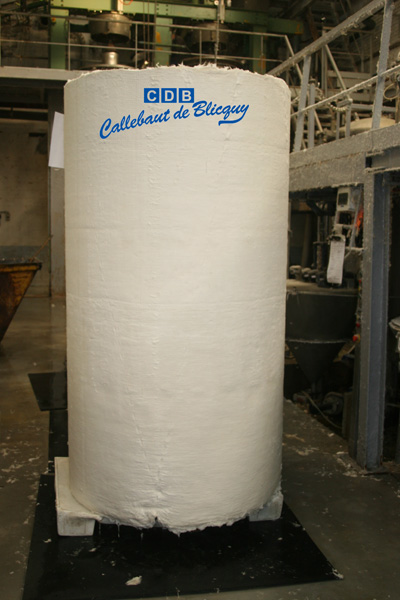The concept of the proposed line is based on two technologies developed by two French companies
- Callebaut de Blicquy (CdB) for bleaching vessel and associated loaded press
- Rousselet Robatel for continuous centrifuge
Bleaching technology
Cotton bleaching performed with kiers from Callebaut de Bliquy is based on concept completely different from the ‘’standard method’’
With this CdB technology, cotton cakes are handled inside material carriers, which can go from loading press to bleaching kiers.
This allows getting cakes with very high density => cake density = 345 kg/m3
Direct savings are got using this method
- cotton cake is perfectly homogeneous, no cracks and preferential channels
- better efficiency of cotton bleaching
- better average quality of cotton bleached by this technology
- less handling cost of cakes though the workshop
On traditional bleaching systems, cotton is not pressed in a material carrier. Raw cotton is highly resilient, thus after pressing it always recovers its initial volume.
Using material carrier, which can be pressed, cotton keeps the volume given during pressing.
High density inside material carrier is the base of this concept.
This high density requires:
- heavy and resistant material carrier which can be pressed
- loading press with high efficiency to get high density
- kiers with high performance pumps to bleach these high density cakes
In conjunction with high density, cotton cakes are very high in comparison with ‘’standard method’’
Cake height is equal to 2,200 mm (we are talking of a single cake, not split with intermediate plates)
This large height in relation with high-density cake allows a complete optimisation of liquor ratio.
CdB effectively guaranty a very low liquor ration => liquor ratio 4.7 litres / kg of dry cotton
Competition can only offer a thru liquor ratio included between 6.5 and 9
This second advantage generates the following savings
- very low water consumption in between 25 and 30 litres of water / kg of cotton (function of cotton origin and selected treatment)
- low water consumption generates saving on the energy to heat this water
- and also saving on ancillary products
- and finally, low water consumption means by consequence less water sent to water treatment plant with the associated cost




